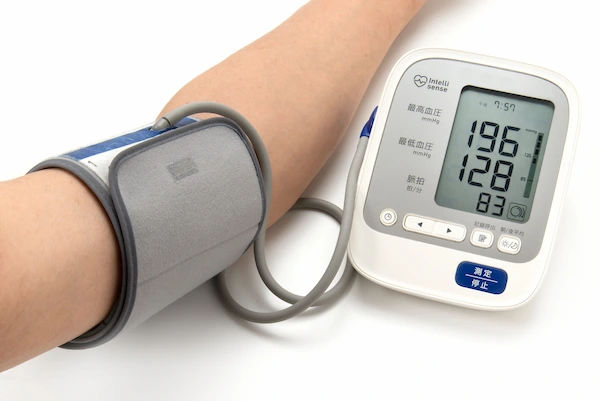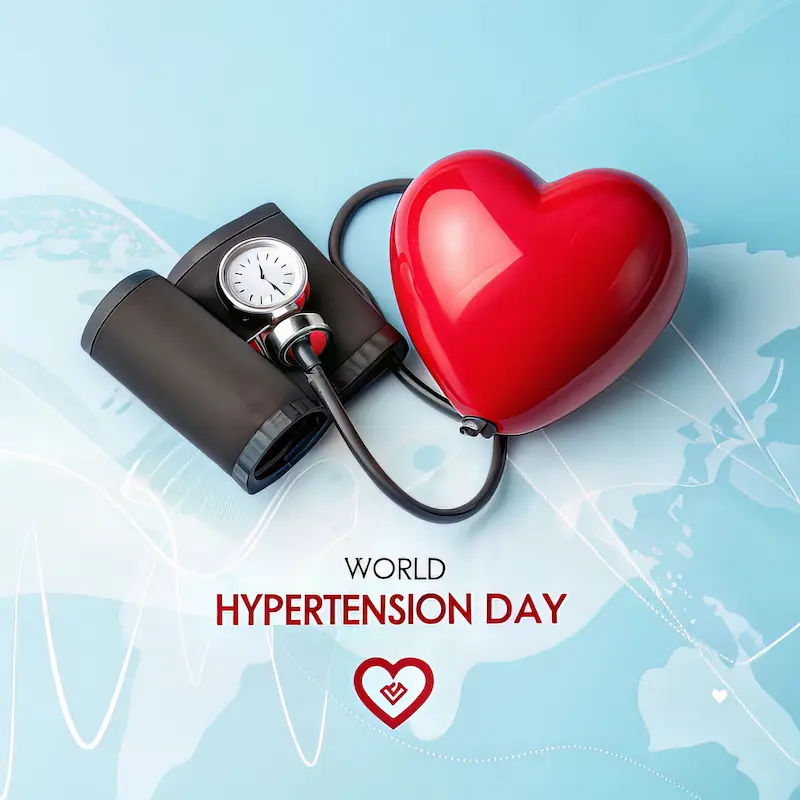Blood Pressure Test

Written by Dr Sonia Bhatt
Last updated on 3rd Jul, 2025
Blood pressure refers to the amount of force blood uses to get through the arteries. Conditions leading to fluctuations in blood pressure can lead to health issues in individuals. However, in case of fluctuations like high blood pressure, there may or may not be symptoms that allow individuals to identify the condition.
Regular blood pressure monitoring helps individuals remain informed about their health condition and avert the risk of serious ailments. It also helps individuals assess how certain changes in lifestyle and medicines are impacting their blood pressure.
Types of Blood Pressure Tests
There are several types of tests for monitoring blood pressure. The most prominent ones include:
- Manual Blood Pressure Test: Blood pressure is measured using a sphygmomanometer (equipment including bulb, gauge, and cuff) and a stethoscope.
- Automated Blood Pressure Monitors: Blood pressure can also be measured using automated blood pressure monitors, which work using the oscillometric method (non-invasive technique).
- Ambulatory Blood Pressure Monitoring: Ambulatory blood pressure monitoring is a technique for measuring blood pressure on a continuous basis for a period of 24 hours.
How to Prepare for a Blood Pressure Test
There are certain factors, like how a patient prepares for the test or how they position the arm, that can cause the reading to change by 10% or more. For the most accurate results, it is important to make sure that patients follow certain steps before the commencement of the test.
Steps to Follow Before the Test
- The bladder should be empty.
- Avoid the consumption of caffeine or should not eat, drink, smoke, or indulge in exercise for 30 minutes to one hour before the test.
- Avoid thinking about stressful things, which might otherwise cause the blood pressure to shoot up.
- Wear a short-sleeved shirt so that the blood pressure cuff can be placed around the arm easily.
Procedure for Conducting a Blood Pressure Test
The procedure for conducting a blood pressure test using a blood pressure cuff, stethoscope, and sphygmomanometer is mentioned below.
- The patient should relax for some time before the readings are taken.
- The blood pressure cuff has to be wrapped evenly around the patient’s arm above the antecubital fossa (triangular-shaped space in the forearm). This position of the cuff provides the most accurate reading.
- The bell of the stethoscope is to be placed over the brachial artery, where the pulse sounds are the strongest.
- After all of this is set, the cuff bulb has to be pumped gradually to listen to the pulse sounds. The Sphygmomanometer reading has to be checked simultaneously.
- Patients should maintain a given posture during and throughout the measurement. They should remain seated with their feet on the floor. The arm should be supported so that the elbow remains at the heart level.
Understanding Blood Pressure Readings
The unit of blood pressure is millimetres of mercury (mmHg). It is represented using two numbers, for instance, 120/80, where-
- Top number: Also known as systolic pressure, this number measures the pressure of blood on the arteries when the heart is beating.
- Bottom number: Also known as diastolic pressure, this number measures the pressure of blood on the walls of the arteries between heartbeats.
Interpretation of Blood Pressure Results
Blood pressure is written as systolic pressure over diastolic pressure, followed by the unit mmHg.
Normal, Elevated, and Hypertension Categories
- Here’s what the various blood pressure readings indicate:
- Normal blood pressure: A blood pressure reading below 120/80 mmHg.
- Elevated blood pressure: The systolic pressure ranges between 120 and 129, and the diastolic pressure is less than 80.
- Stage 1 high blood pressure: The systolic pressure ranges between 130 and 139, and the diastolic pressure ranges between 80 and 89.
- Stage 2 high blood pressure: The systolic pressure is higher than 140, and the diastolic pressure is higher than 90.
- Hypertensive crisis: The systolic pressure is over 180, and the diastolic pressure is more than 120. This situation may lead to severities like kidney damage, stroke, or heart attack.
Factors Affecting Blood Pressure Readings
Even the slightest of changes can cause the blood pressure to fluctuate to a great extent. Listed below are some factors that affect blood pressure readings.
Temporary Influences on Blood Pressure
- The following factors may cause an individual’s blood pressure to change temporarily:
- Size of the pressure cuff: Using a small pressure cuff can cause the blood pressure reading to shoot up by 10 to 40 mmHg.
- Using the pressure cuff over clothing: The pressure cuff should be placed directly on the arm, touching the skin.
- The stethoscope’s bell should be placed over the brachial artery for the most accurate reading.
- Emotional state: If an individual does not rest a few minutes before sitting for the blood pressure test or if someone thinks about something tense, the blood pressure reading can increase significantly.
- Talking: Talking during the blood pressure measurement can cause the blood pressure to rise by 10 to 15 mmHg.
Tobacco, alcohol, or caffeine consumption: One should refrain from smoking or drinking (alcohol or caffeine like tea, coffee, or soda) for at least 30 minutes before having a blood pressure measurement taken.
Permanent Conditions Affecting Blood Pressure
The following factors may affect an individual’s blood pressure permanently:
- Age: As people grow older, their arterial pressure increases. This increases the risk of high blood pressure.
- Menopause in women: Women usually tend to have lower arterial pressure than men who fall in the same age group. After women go through menopause, they tend to have a blood pressure almost equivalent to men.
- Obesity: There is a well-established relationship between adiposity and high blood pressure. Studies have shown that obesity is responsible for 65-78% of instances of primary hypertension.
- Certain health conditions: Individuals who may be under medication to treat a certain health condition are also likely to have their blood pressure go up.
What are the Risks of High Blood Pressure?
High blood pressure can potentially risk the well-being of various organs:
- Arteries: High blood pressure damages the cells of the inner lining of the arteries.
- Heart: High blood pressure can lead to artery disease, heart failure, etc.
- Brain: There may be a risk of mini-stroke when blood supply to the brain is blocked.
- Kidney: Damaged blood vessels hinder filtration, thereby resulting in kidney failure.
- Eyes: High blood pressure can harm blood vessels that supply blood to the different parts of the eyes, thereby risking partial or complete vision loss.
Who Should Consider Regular Blood Pressure Testing?
The following groups of people should get their blood pressure checked regularly:
- People who have attained the age of 40
- People who have a family history of hypertension
- Pregnant women or women who are nearing or have attained menopause
- Obese individuals
- People who have a habit of smoking or drinking
- People who lack physical activity
- People with a pre-existing medical condition like cholesterol, diabetes, heart disease, etc.
Preventative Measures for Health Maintenance
Resort to the following tips to combat the risks associated with high blood pressure:
- Consume a healthy diet
- Engage in regular physical activity
- Limit alcohol consumption and smoking
- Maintain a healthy weight
- Control the cholesterol and blood sugar levels
- Manage stress
- Get quality sleep
Interventions Based on Blood Pressure Test Results
Lifestyle changes can help effectively manage high blood pressure. Alongside the above-mentioned lifestyle changes that individuals should undergo to manage blood pressure, medical treatment is also necessary.
Medical Treatments and Monitoring
The medicines that can treat high blood pressure are:
- Diuretics or water pills: They remove water and sodium from the body.
- Angiotensin-converting enzyme (ACE): They help the blood vessels relax.
- Angiotensin II receptor blockers (ARBs): They help the blood vessels relax or slow the heart rate.
- Some other medicines that can treat hypertension are Alpha blockers, Alpha-beta blockers, Beta-blockers, Aldosterone antagonists, Renin inhibitors, and Vasodilators.
Conclusion
Regular blood pressure monitoring is important for maintaining overall health and preventing complications like kidney damage, heart disease, or stroke. Based on the blood pressure readings, an individual can adopt healthy lifestyle habits, seek timely medical intervention, and keep their blood pressure under check to avert health hazards.
Therefore, it is important to prioritise regular checkups so that individuals can remain informed and take control of their health.
Consult Top Cardiologist
Consult Top Cardiologist

Dr. Tripti Deb
Cardiologist
40 Years • MBBS, MD, DM, FACC, FESC
Hyderabad
Apollo Hospitals Jubilee Hills, Hyderabad

Dr. Zulkarnain
General Physician
2 Years • MBBS, PGDM, FFM
Bengaluru
PRESTIGE SHANTHINIKETAN - SOCIETY CLINIC, Bengaluru

Dr. Anand Ravi
General Physician
2 Years • MBBS
Bengaluru
PRESTIGE SHANTHINIKETAN - SOCIETY CLINIC, Bengaluru
Dr Moytree Baruah
Cardiologist
10 Years • MBBS, PGDCC
Guwahati
Apollo Clinic Guwahati, Assam, Guwahati

Dr. Haider Shaik.
Cardiologist
5 Years • MBBS, MD (Pulmonology) DrNB (Cardiology)
Guntur
Kalam chest and multi-speciality clinic, Guntur


